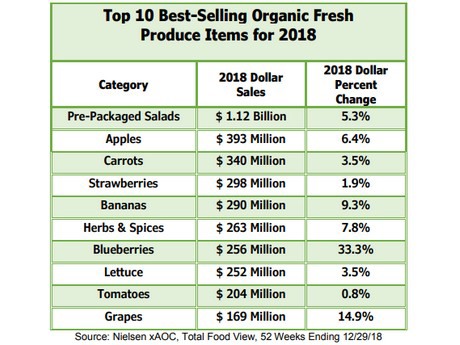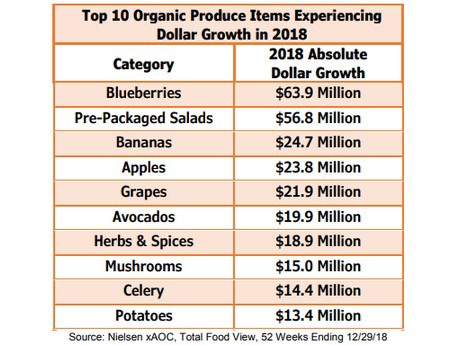In a year when total grocery store dollar growth only reached two percent, organic fresh produce once again surpassed the status quo according to new information released by the Organic Produce Network and Nielsen. In total, organic produce sales in the United States reached $5.6 billion in 2018, with the year ending on a particularly high note as sales increased 13 percent the final week of the year.
“Although organic accounted for 10.1 percent of total produce sales, it’s driving a disproportionate amount of growth within the produce department. In total, 43 percent of total produce growth occurred from organic items which equates to an additional $450 million sold,” said Matt Lally, associate director at Nielsen.

Fresh produce represented 26 percent of total store organic sales and a growth rate of 8.6 percent was on par with total store organic, which suggests a continued movement toward mainstream demand across product consumption. Blueberries increased the most absolute dollars, followed by prepackaged salads. Organic bananas, apples and grapes all exceeded $20 million in growth as well.
“What’s especially interesting about the 2018 numbers is an impressive two-thirds of all produce commodity groups increased organic sales year-over-year which indicates this is not an isolated incident. Perhaps most importantly, organic growth occurred in these three categories despite a decline in conventional sales," said Matt Seeley, CEO of the Organic Produce Network.
At the same time, organic isn’t a guaranteed success in produce, they said. Products like strawberries and tomatoes experienced far greater growth in the conventional offering. A closer look reveals how important pricing is for these categories. Prices were an astoundingly different $1.97 to $3.38 per pound between conventional and organic tomatoes and $2.26 to $4.26 for conventional and organic strawberries.

“When you compare this difference with commodities that experience a high organic growth rate such as grapes, the difference is striking. Conventional grapes rang in at $2.18 per conventional pound compared to $2.94 per organic pound. Clearly there’s a strong connection between the growth of organic and the price premium with its conventional counterpart," Lally said.
Strawberries and tomatoes, however, aren’t the only products with room for growth. Onions, bell peppers, watermelon and mandarins are all still disproportionately under-represented in organic sales compared to the total produce average. Ensuring organic items are widely available for purchase, particularly at key times of the years such as summer holidays, Thanksgiving and Christmas, is a good starting point for commodities still trying to reach more organic shoppers.
With a focus on increased availability and a strategic pricing approach, 2019 could shape up even better for the organic produce industry.
For more information:
Matt Seeley
Organic Produce Network
Ph: +1 (831) 884-5058
[email protected]
www.organicproducenetwork.com










